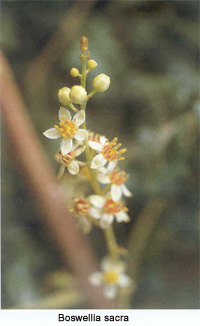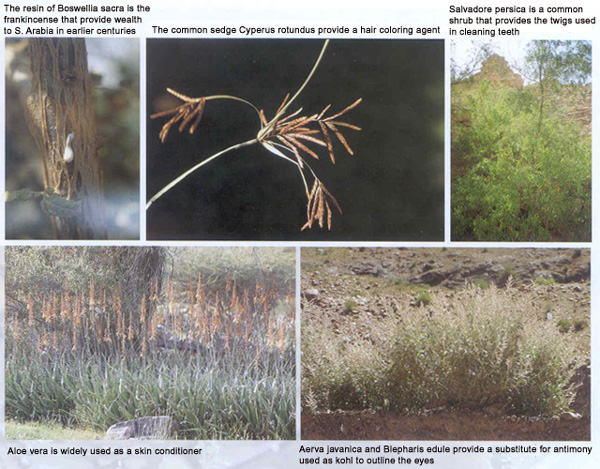|
 Not
long ago the people that lived in the UAE
had little or no contact with the outside
world. Especially the womenfolk of the bedu
tribes of the inland deserts lived an
isolated existence. Along the coast things
were a little different, for there the
trading dhows would bring goods from places like
Persia
,
India
and
even
Africa
. Among
these goods would be jewelry, perfumes and
cosmetics.
Not
long ago the people that lived in the UAE
had little or no contact with the outside
world. Especially the womenfolk of the bedu
tribes of the inland deserts lived an
isolated existence. Along the coast things
were a little different, for there the
trading dhows would bring goods from places like
Persia
,
India
and
even
Africa
. Among
these goods would be jewelry, perfumes and
cosmetics.
The women of the nomadic tribes had to
make use of the materials they could find
in their environment - what little water
there was, had to be used for drinking and
cooking and for the five times daily
ablutions of hand and feet. There was not
water to bathe in. Fortunately the dry air
of the desert made body sweat evaporate
very quickly so that their wide dresses
would not be soaked. If, however, it
became necessary to clean the body, the
sap of the Aloe
plant, widely used all over the world to
clean and soften skin, would be used as a
cleansing agent. Also the powdered leaves
of the Indian laurel tree (warq
al ghar) were used as a soap
substitute. In neighbouring countries the
leaves of the saltbushes Haloxylon
salicornicum and Seidlitzia
rosmarinus were used to produce soap
substitute
A special problem was how to keep the hair
clean. For this the dry powder of oily
seeds (mahalleb)
was applied to and worked through the hair
to extract the dirt and condition the
hair. An added benefit was that the oil
kept the hair together so that it would
not blow in the wind or fall down. In
Oman
the crushed leaves of the sidr
tree (Zizyphus
spinachristi) were used to clean the
hair, which was said to become very
lustrous and soft due to this treatment.
Although the sidr
tree grows in wadis and plantations in the
UAE, this use does not seem to have been
made of it here.
Another way to ensure fresh smelling
clothes was to fumigate them with the
smoke of burning wood chips of fragrant
woods such as sandalwood and other
species. This "oudh
was burned in an incense burner that was
passed underneath the clothes as they were
being worn. Sometimes a special stand,
made of the midribs of a palm tree was
used to hang up the clothes and the
incense burner was placed beneath it.
Besides 'oudh,
the women used to use bakhoor
- small round cakes of pulverised 'oudh
wood, musk and Arabic perfumes. Few people
could afford the luxury of frankincense or
laban,
the dried resin of the Boswellia
sacra tree that grows in the Dhofar
region of southern Arabia.
The desert bedu
women did not use any perfumes other than
the oil of 'oudh
wood (dahan
al 'oudh), but the coastal tribes imported perfumes from India and
Persia.

The teeth were cleaned by chewing on twigs
of the shrub or tree Salvadore
persica, locally called ra'
or
rak. The very common sedge Cyperus
rotundus was used in a powder to
whiten the teeth.
People that grew the local variety of
sweet basil in their plantations used to
rub their hands with the crushed leaves to
give them a pleasant smell,
Make-up was also virtually unknown. The
skin of the face was kept supple and
pretty by the application of wars
in the summer. This was a turmeric-coloured
powder made from the seeds of a tree,
reportedly from India. In winter the women
protected their skin by applying a dye
made from gentian violet crystals that
also had an antiseptic action. The inside
of the burqa
or facemask was painted with this purple
dye.
Eye make-up consisted mainly of kohl,
which came in two forms. One was a powder
made of antimony sulphide called athmet, which was mainly used as a medical treatment to prevent or
heal eye infections. The other was a
sticky substance called serrai,
which was a true cosmetic and was rolled
onto the eyelid by means of a small ivory
stick called merwad.
The common plants Blepharis
edule and Aerva javanica provided the women with a substitute for the antimony
that had to be imported. For this they
roasted and powdered roots of the plants
and made a paste by mixing it with some
water, ground for a second time and spread
in the sun to dry. Sometimes some
mother-of-pearl from ground shells was
added to give additional sparkle to the
powder. Kohl around the eyes helped to reduce sun glare and kept the eye
moist in the dry desert air. In early
times 'ilm
al-koh meant the science of
ophthalmology!
Local women did not use rouge or lipstick,
contrary to the bedu
of Africa, who reportedly used the red dye
contained in the roots and twigs of the
Arabian primrose (Arnebia
hispidissima) for this purpose. Those
tribes also knew how to extract the indigo
dye from the various species of Indigofera
that abound in the desert. Although all
these species of plant are present in our
deserts, they do not seem to have been
used locally. In Oman a purple dye
extracted from the berries of Solanum
nigrum (deadly nightshade) was used
for similar purposes (dyeing clothes and
skin) as the indigo dye elsewhere. More to
the West the parasite Chrozophora
tinctoria was used to produce an
indigo dye, while the Red Thumb Cynomorion
coccineum provided a red colour. In
the mountains Dicoma schimperi was the source for a yellow dye.
The use of the reddish dye from the Lawsonia
inerme tree, henna,
came to the UA E from India. Its use was
restricted to brides and older women. The
older women used to cover an area roughly
the same as that covered by gloves or
socks (ghimsah) with solid dye, claiming that it cooled the hands and feet
in summer and protected the skin in
winter. Brides had a small lump of henna
paste placed into the palm of their hands.
When they closed their fingers around this
lump it would colour their palms in a
striped pattern. None of the intricate
flowery patterns were used by local women.
At best some dotted lines were painted on
top of the fingers and the fingertips
might be covered with dye.
Application of henna
to the hair was only done as a medical
treatment for headache and not as
colouring agent. However, the seeds of the
Desert squash (Citrullus
colocynthis) were crushed and mixed
with water to darken the hair.
Mountain dwelling people had a few more
plants to add to their beauty care range.
The leaves of Indigofera
oblongifolia were crushed in water and
used as soap. The bark of the Moringa
peregrina tree was used to remove
freckles, while the sap of Ficus
trees was effective in removing warts. The
crushed leaves of Helichrysum
and Cleome
brachycarpa plants were used as a
deodorant.
|
